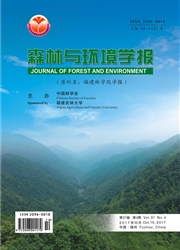

 中文摘要:
中文摘要:
在12年生的杉木人工林中开展4种水平的模拟氮沉降试验,分别为N0(对照)、N1、N2、N3,N沉降量依次为0、60、120、240 kg·hm-2·a-1。通过对凋落物的化学分析发现,4种微量元素在凋落物各组分中的年平均含量大小表现为Fe〉Mn〉Zn〉Cu。氮沉降处理,尤其是中低水平的氮沉降(N1、N2)明显增加了凋落叶中Mn、Fe元素的含量,但在一定程度上降低了Zn元素含量。各微量元素在1 a中出现2个养分归还高峰期,第1次峰值大都出现在4月份,但第2次峰值出现的时间不一致。经N0、N1、N2、N3处理,Cu元素的年归还量分别为8.69、8.99、9.79和8.77 g·hm^-2;Mn元素年归还量分别为244.91、293.95、278.68和200.99 g·hm^-2;Zn元素年归还量分别为40.08、42.92、44.73和38.63 g·hm^-2;Fe元素年归还量分别为459.00、614.09、598.81和406.28 g·hm^-2。相对于N0处理,N1、N2处理表现出提高凋落物Cu、Mn、Zn、Fe元素归还量的正作用,而N3处理表现为负作用。
 英文摘要:
英文摘要:
In a 12-year-old Chinese fir plantation, a field experiment was conducted with annual nitrogen additions at 4 levels as NO (0 kg·hm^-2·a^-1) , Nl(60kg·hm^-2·a^-1) , N2 (120 kg·hm^-2·a^-1) and N3 (240kg·hm^-2·a^-1) , with3 replicates in each treatment. Based on chemical analyses, the annual average concentrations of 4 microelements in the litterfall decreased in the following order: Fe 〉 Mn 〉 Zn 〉 Cu. Nitrogen additions, especially low-to-medium N treatments ( N1 and N2) elevated the contents of Mn and Fe in the litterfall, but reduced Zn concentration to some extent. The micronutrient flux through litterfall exhibited two peaks, the first occurring consistently in April, but the second differently among the elements. Through litterfall production, the annual flux of Cu to the forest floor was estimated at 8.69, 8.99, 9. 79 and 8. 77 g·hm^-2 ; of Mn at 244. 91, 293.95, 278. 68 and 200.99g·hm^-2 ;of Zn at 40. 08, 42.92, 44.73 and 38.63 g·hm^-2; of Fe at459.00,614.09,598.81 and 406.28 g·hm^-2 ; respectively, for the above 4 treatments ( N0, N1, N2 and N3). The annual flux for the microelements responded positively to N1 and N2 treatments, but negatively to N3.
 同期刊论文项目
同期刊论文项目
 同项目期刊论文
同项目期刊论文
 期刊信息
期刊信息
